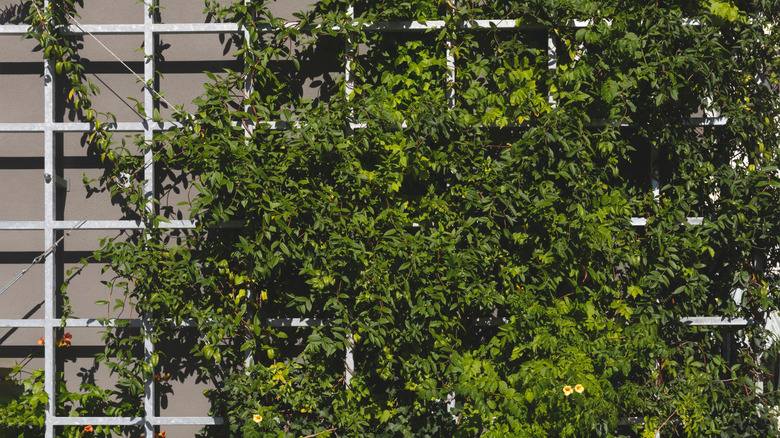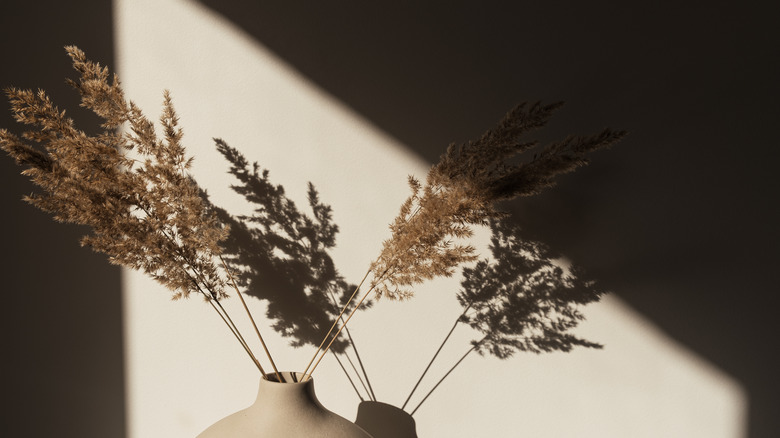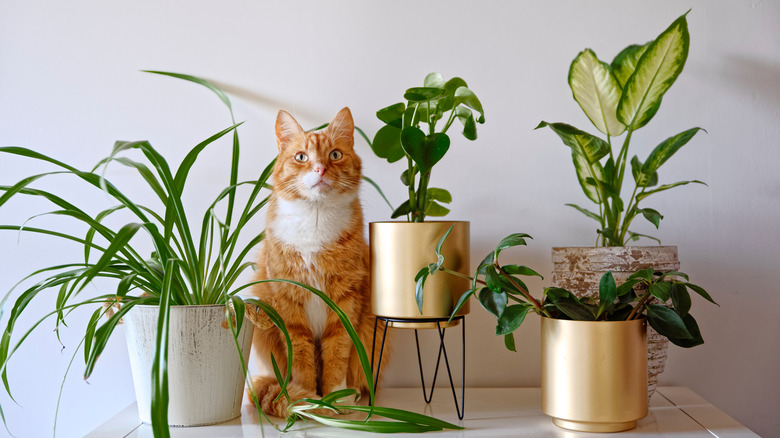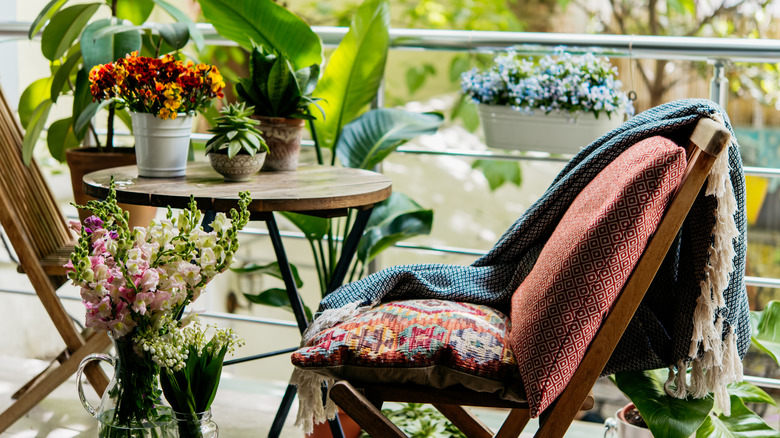What Is Biophilic Design And Is It Right For Your Home?
Biophilia is a design philosophy that purports to fulfill the human tendency towards regular interaction with the natural world. It emerges at the intersection point between humankind and nature, and in the realm of interior design, it is achieved either by expanding a space towards nature or inviting the outdoors in.
The term "Biophilia" was initially used by a German social psychologist named Erich Fromm in 1964 to describe personality characteristics, according to Frontiers. Derived from the literal definition of the word, Fromm defines its meaning as "the passionate love of life and of all that is alive." In 1984, Edward Wilson further expanded on the topic, arguing that people have an innate fondness for nature that is based in our biological makeup, but in modern times that inclination must be cultivated (per PBS). Throughout history, however, elements of biophilic design have inspired works of architecture, from the trellised green walls of the Roman Empire to the Alhambra of Granada, Spain. In fact, several ancient cultures considered nature to be divine.
Prominent individuals such as Leonardo DaVinci studied natural elements such as the motion of water and the flight of birds as inspiration for his iconic designs and inventions, according to Metals Magazine. Thus, it's safe to say that biophilia has been influencing design long before the term was coined and defined — lending credence to Wilson's claim that it is something innate. While all of this may seem rather complicated, there are actually several easy ways to use the principles of biophilia to introduce elements of the natural world into the indoor spaces where we spend most of our time.
Common elements of biophilia
Today, the unfortunate reality is that many people spend a large portion of their time confined indoors in manufactured spaces composed of artificial materials, rarely referencing any link to nature. The good news, however, is that design seems to be trending towards a healthier balance between the convenience of internal spaces and our inclination to be closer to nature. Biophilic design could in fact be the answer in addressing this divide.
The most obvious way to bring the outdoors in is to add houseplants to your decor, but biophilic design is not restricted to living plants; there are several elements you can incorporate. Sunlight is a clear marker of natural spaces, and can easily be brought into your space. It's free, versatile to match any type of decor, and even provides us with the added health benefits of vitamin D, as ScienceDirect points out. The sun is also a marker of the passing of time, and it can be used to strengthen our awareness of the time of day even when we are focused on indoor activities. Sunlight is also necessary if you are attempting to grow houseplants indoors, and the better it is utilized, the less artificial light is needed, at least during the daytime.
Air is another element that connects us to nature, making proper ventilation a key component of biophilic design. The chill of an AC unit or dryness of a space heater can feel unnatural if it differs too much from your local outdoor environment. The National Institute of Building Sciences encourages instead the use of natural ventilation systems and passive heating and cooling, similar to methods used before modern technology was developed. Not every influence has to be dynamic, however. Darker, calming spaces can also pull influence from nature through the use of materials such as wood, stone, wool, leather, and more.
How to implement biophilia in your home
As previously mentioned, plants are an obvious way to incorporate the indoors, but you can take it further and truly follow biophilic design by using hanging baskets or trellises to better mimic the natural habitat in which they grow. In conjunction, it is important to provide them, and the people using the space, with plenty of sunlight. Features such as expansive windows or strategically placed skylights should be considered as ways to control exposure to the elements so you can maintain the proper balance between biophilic design and the functionality of an indoor space.
Leisure spaces are commonly those that bridge the gap between indoors and out. Semi-sheltered structures such as a screened-in porch, covered patio, or backyard gazebo are enjoyed largely due to their exposure to the sounds of nature and fresh air. To make the most of this element indoors, you can design the layout so that windows can easily be accessed and opened on a whim to fill the room with a pleasant breeze.
Another way to reconnect with nature is to invite it into your space in a more literal sense by deciding to become a pet owner. Inverse reports that our love of pets stems from an innate sense of biophilia, and they can improve our well-being by encouraging exercise, facilitating social interaction, and even reducing stress levels. As you adapt your space to make it a suitable environment for a dog or cat, you will end up being guided by and in tune with biophilic principles without even realizing it. In addition, your pet's dynamic energy will provide balance against the stuffier, static elements of your home, better reflecting the relationships that take place in nature.
Following biophilic design consists of more than just inviting the outdoors in, but instead runs deeper to encourage applying the principles of nature to indoor spaces and fixtures. Using man-made materials is inevitable, but you can opt for pieces that mimic nature's colors, patterns, and textures. With such diverse offerings available, you're bound to find some way to incorporate natural elements into your own unique style. If you're ever stuck or unsure how to proceed, you can turn to the natural world. Gaze at the way a wave moves in the sea. Ponder the intricacies of an orchid flower or a zebra's skin. Biophilic applications are endless, and everyone has a cheat sheet from nature from which they can draw inspiration.
Biophilia vs. biomimicry
Biomimicry is another nature-based design philosophy that shares much in common with biophilia, though there are distinct differences. While biophilia encourages us to welcome nature out of an innate love and desire to connect, biomimicry employs a more strategic approach, instead striving to imitate nature's forms and structures with the belief that natural systems are inherently efficient (per Terrapin Bright Green). Biophilia is more focused on the mental and physical benefits that connection with nature can provide, whereas biomimicry reveres nature as an example of innovative engineering and efficient design.
A well-known example of biomimicry includes the development of velcro, as Micro Photonics Inc. explains. In 1941, after contemplating the difficulty in removing burrs from himself and his dog after an afternoon hunt, inventor George de Mestral was inspired to study the structure of the burrs and mimic it in his own creation, the velcro fastener we still use today. Though mosquitos are universally considered a nuisance, we can all be grateful for the fact that their blood-sucking appendage is serving as a model for a pain-free hypodermic microneedle, according to GATC.
While biomimicry suggests admiration for nature, it's less of an emotional experience than biophilia. When the two philosophies are combined, however, out of a love of nature emerges innovations that emulate its patterns, along with the intention to protect or even restore the natural world.
Why you should use biophilic design
In addition to the natural sense of comfort that alignment with nature provides, there are several therapeutic qualities and wellness benefits to embracing biophilic design. As mentioned by ScienceDirect, research by Tina Bringslimark and colleagues has shown that indoor plants have a noticeable effect in reducing stress and aiding pain management in humans that interact with them. These qualities are especially desirable in spaces you intend to relax, such as your bedroom or living room.
Biophilic design also helps us better attune to our surrounding environment in part by stimulating our senses, as Forest Homes points out. This heightened awareness of the world around us can lead to a greater sense of empathy with others and with nature, which in turn encourages more sustainable lifestyle practices. As biophilia continues to gain in popularity, humankind moves closer to living in symbiosis with nature as we did in the past. You can use this guide to stay ahead of the trend and start taking steps to promote biophilia in your own home, for you and your family to enjoy the many benefits it provides.




